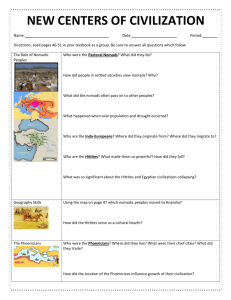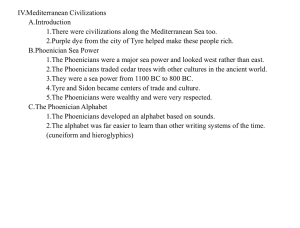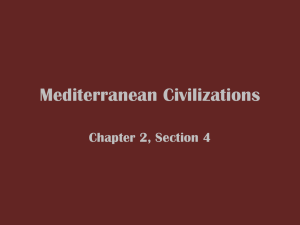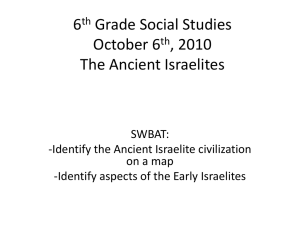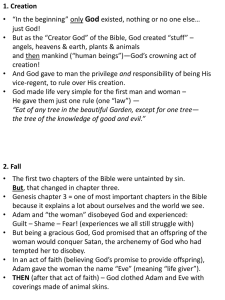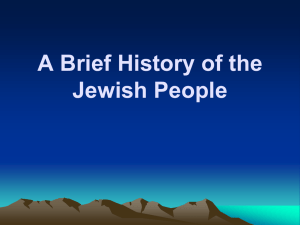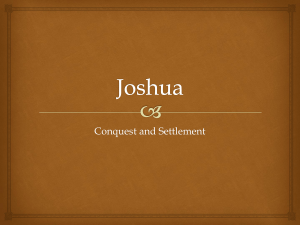Israelite
advertisement
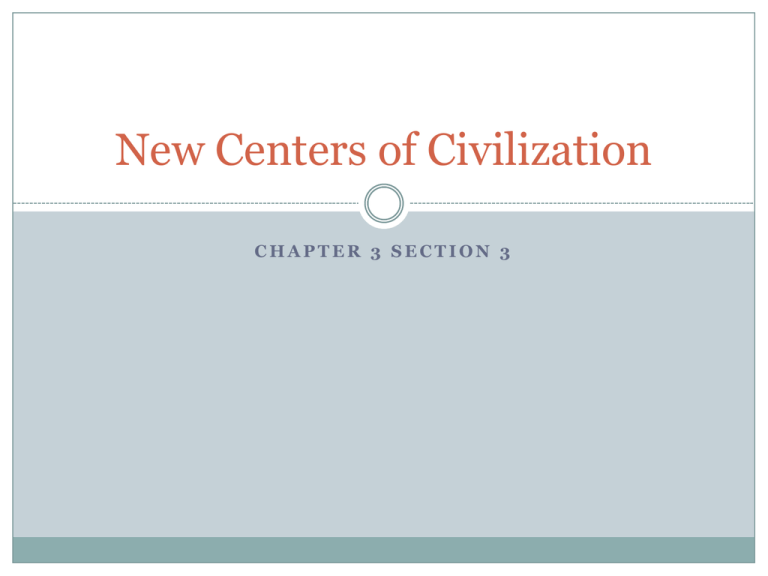
New Centers of Civilization CHAPTER 3 SECTION 3 The Role of Nomadic Peoples In the area of Central Asia a civilization flourished around 4,000 years ago. On the edges of this civilization were pastoral nomads, who occasionally overran settled communities and then created their own empires. These nomads used domesticated animals for food and clothing and used regular migratory routes to provide food for their animals. Central Asia The Role of Nomadic Peoples Settled communities often viewed nomadic people as barbaric. Nomads would interact with settled communities to trade and act as couriers from one community to another. In times when normal patterns were disrupted for nomadic peoples they would often attack settled communities for food and supplies. The Role of Nomadic Peoples One of the most important group of nomadic peoples were the Indo-Europeans. Their languages included Greek, Latin, Persian, Sanskrit and Germanic. Around 1750 B.C. a group of Indo-Europeans moved into Asia Minor and Anatolia and formed the Hittite Kingdom with a capital located at Hattushash. The Hittite Kingdom The Role of Nomadic Peoples Between 1600 and 1200 B.C. the Hittites created an empire in western Asia and threatened the power of the Egyptians. The Hittites were the first to wield iron weapons which were stronger than the commonly used bronze weapons. Around 1200 B.C. the Hittite Empire was destroyed by a group of people only known as the “Sea Peoples”. Extent of the Hittite Empire The Phoenicians The Phoenicians lived in what is now modern day Lebanon. Their main focus was overseas trade as they produced purple dye, glass and cedar for export to foreign markets. The main centers for the Phoenicians were the cities of Byblos, Tyre, and Sidon. The Phoenicians The Phoenicians built ships from cedar and established an extensive trade routes and colonies throughout the Mediterranean. The Phoenicians ships, called Triremes, are thought to have reached as far as the coast of Great Britain. Phoenician Trade The Phoenicians The Phoenician culture is best known for its alphabet. The Phoenicians simplified their writing by using 22 different signs to represent the sounds of speech. It would eventually be passed on to the Greeks which was adopted and changed into the Roman alphabet which we use today. The Phoenician Alphabet The Israelites Abraham is considered to be the father of the Hebrew nation. He and his household left the Mesopotamian city of Ur and settled in Canaan. The land of Canaan contained rocky hills and desert, fertile plains, and grassy slopes, with the best farming in the Jordan River Valley. Abraham’s Journey to Canaan The Israelites The Hebrews believed in one God, Yahweh or Jehovah. Their belief in one God, or monotheism, made them different than the surrounding cultures. God made a covenant or agreement with Abraham telling him that he would make a great nation from Abraham’s descendants if they would remain faithful to “Abraham’s Journey from Ur to Canaan” him. (Jozsef Molnar, 1850) The Israelites Abraham’s grandson Jacob, also known as Israel, raised twelve sons in Canaan, each led a separate family group or tribe which became the 12 tribes of Israel and would become known as the Israelites. The Israelites During a severe drought in Canaan the Israelites migrated or moved to Egypt. The Israelites lived in the Egyptian province of Goshen peacefully for several generations until the pharaohs decided to enslave them. The Israelites The Hebrews life became hard as they were forced into hard labor. The Israelites believed that God would send them a deliver to lead them out of Egypt. Moses, a Hebrew raised in the royal palace would reject his Egyptian upbringing and lead his people out of captivity. “Departure of the Israelites” (David Roberts, 1829) The Israelites Moses would rally his people and lead them out of Egypt in a mass Exodus. During their time in the desert of the Sinai Peninsula, God renewed his covenant with the Israelite people and gave them the Ten Commandments. In return for their loyalty the Israelites were promised the land of Canaan. The Land of Canaan The Israelites Moses would die before "The Children of Israel Crossing the Jordan" (Gustave Dore 1883) reaching the land of Canaan and the Israelites would be led across the River Jordan by Joshua, their new leader. The Israelites would spend over 200 years trying to gain control of the region. They at first would be ruled by a set of Judges, who were temporary leaders in times of danger. The Children of Israel Crossing the Jordan" (Gustave Dore 1883) Possible Route of the Exodus The Israelites The Israelites would spend over 200 years trying to gain control of the region. They at first would be ruled by a set of Judges, who were temporary leaders in times of danger. The 12 tribes of Israel would settle in Canaan and divide the land among themselves. The Israelites Around 1020 B.C. the Israelite tribes would face pressure from the attacking Philistines. They would unite under one king, Saul. Saul would be unable to defeat the Philistines. He would be succeeded by a shepherd named David. David had once fought the Philistine giant named, Goliath. “Saul and David” (Rembrandt, 1670) The Israelites David would take the “King David Playing the Harp” (Gerard van Honthorst, 1622 throne of Israel in 1012 B.C. He would set up a religious and political capital at Jerusalem, expanded Israel's borders, and centralized the government. Israel's borders would encompass all of Canaan from the desert to the sea. King David’s Kingdom The Israelites David’s son Solomon would rule after his father and would bring Israel to the height of its power. Solomon was responsible for building the temple in Jerusalem. It would become the center of worship in the Kingdom of Israel. Solomon’s Temple The Israelites After the death of Solomon the ten northern tribes separated and formed an independent Kingdom of Israel with a capital at Samaria, and the two southern tribes were known as the Kingdom of Judah. The Israelites In 722 and 721 B.C. Israel was conquered by the Assyrians who sent many Israelites to parts of the Assyrian Empire. It was during this time that they would merge or assimilate into surrounding cultures, losing their identity. Assyrian Exile of Israel The Israelites The Kingdom of Judah remained independent until the Chaldeans of Babylon defeated the Assyrians and conquered Judah. The people of Judah (Jews) were taken to Babylon. Their captivity lasted 70 years until the Persians conquered Babylon and they were allowed to return to Judah. Judah’s Exile to Babylon
